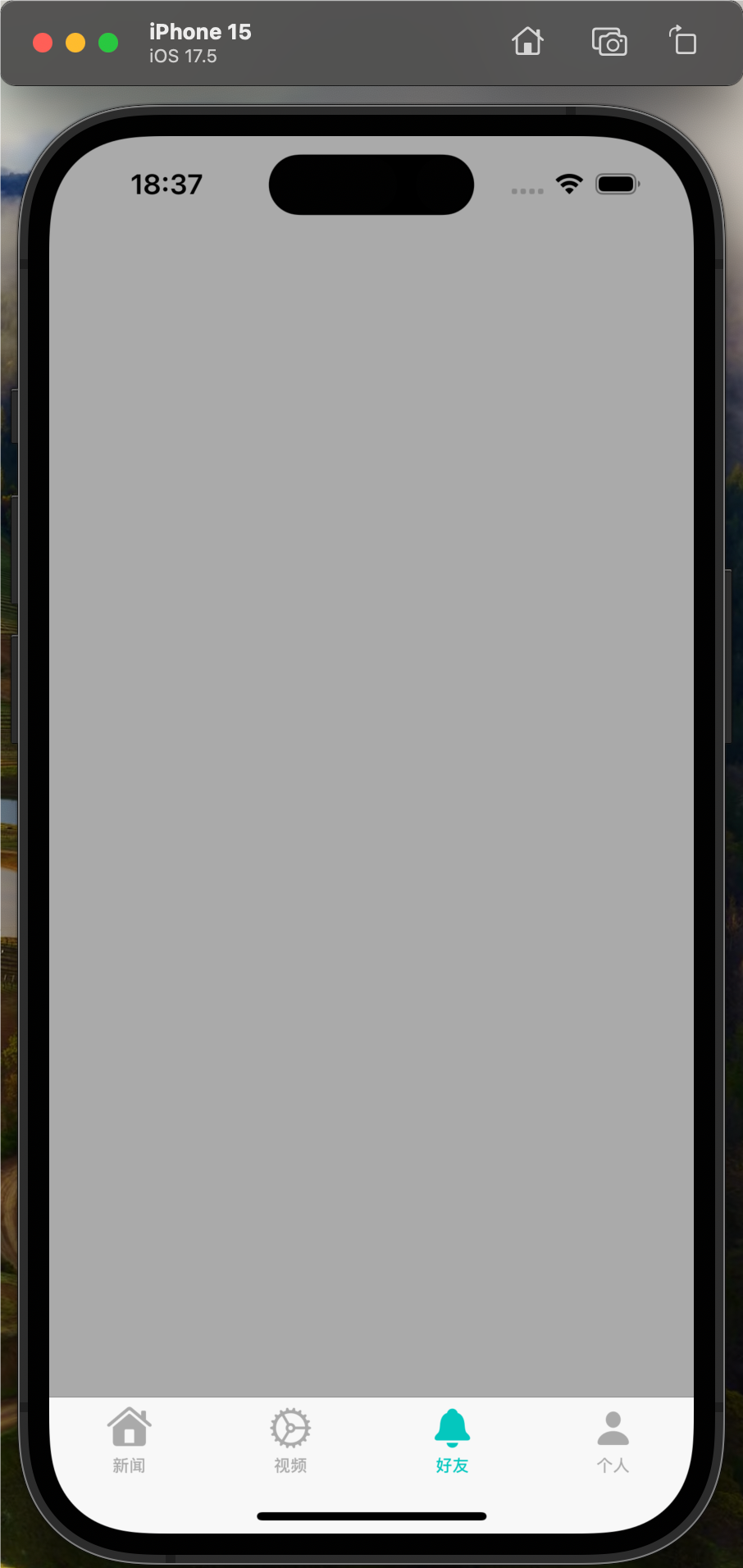我怎么想象这可能是有用的,通过指定基本上四个“路径段”,可以是Bézier曲线或直线段(通常可以在CGPath或UIBezierPath中创建的任何单个“元素”)定义四个边缘的形状文本的边界框.
此文本不需要是可选择的.它也可能是一个图像,但我希望找到一种在代码中绘制它的方法,因此我们不必为每个本地化都有单独的图像.我喜欢使用CoreGraphics,NSString / NSAttributedString绘图添加,UIKit / TextKit甚至CoreText的答案.我只是决定在使用OpenGL或Metal之前使用图像,但这并不意味着我不会接受一个好的OpenGL或Metal答案,如果它实际上是唯一的方法.
解决方法
我能够使用许多近似技术来实现它.我使用近似(通过CGPathCreateCopyByDashingPath)做的大部分工作,理论上可以用更聪明的数学代替.这可以提高性能并使得结果路径更平滑.
基本上,您可以参数化顶线和基线路径(或接近参数化,就像我所做的那样). (您可以定义一个函数,该函数沿路径获取给定百分比的点.)
CoreText可以将每个字形转换为CGPath.使用一个函数在每个字形路径上运行CGPathApply,该函数将沿路径的每个点映射到沿文本行的匹配百分比.将点映射到水平百分比后,您可以沿着顶线和基线沿该百分比的2个点定义的线进行缩放.根据线的长度与字形的高度来缩放沿该线的点,并创建新的点.将每个缩放点保存到新的CGPath.填写那条路.
我已经在每个字形上使用了CGPathCreateCopyByDashingPath来创建足够的点,我不需要处理数学来曲线化一个长的LineTo元素(例如).这使得数学更简单,但可以使路径看起来有点锯齿状.要解决此问题,您可以将生成的图像传递到平滑过滤器(例如CoreImage),或将路径传递给可以平滑和简化路径的库.
(我原本只是尝试使用CoreImage失真滤镜来解决整个问题,但效果从未产生过正确的效果.)
这是我如何工作(180行,滚动):
static CGPoint pointAtPercent(CGFloat percent,NSArray<NSValue *> *pointArray) {
percent = MAX(percent,0.f);
percent = MIN(percent,1.f);
int floorIndex = floor(([pointArray count] - 1) * percent);
int ceilIndex = ceil(([pointArray count] - 1) * percent);
CGPoint floorPoint = [pointArray[floorIndex] CGPointValue];
CGPoint ceilPoint = [pointArray[ceilIndex] CGPointValue];
CGPoint midpoint = CGPointMake((floorPoint.x + ceilPoint.x) / 2.f,(floorPoint.y + ceilPoint.y) / 2.f);
return midpoint;
}
static void applierSavePoints(void* info,const CGPathElement* element) {
NSMutableArray *pointArray = (__bridge NSMutableArray*)info;
// Possible to get higher resolution out of this with more point types,// or by using math to walk the path instead of just saving a bunch of points.
if (element->type == kCGPathElementMoveToPoint) {
[pointArray addObject:[NSValue valueWithCGPoint:element->points[0]]];
}
}
static CGPoint warpPoint(CGPoint origPoint,CGRect pathBounds,CGFloat minPercent,CGFloat maxPercent,NSArray<NSValue*> *baselinePointArray,NSArray<NSValue*> *toplinePointArray) {
CGFloat mappedPercentWidth = (((origPoint.x - pathBounds.origin.x)/pathBounds.size.width) * (maxPercent-minPercent)) + minPercent;
CGPoint baselinePoint = pointAtPercent(mappedPercentWidth,baselinePointArray);
CGPoint toplinePoint = pointAtPercent(mappedPercentWidth,toplinePointArray);
CGFloat mappedPercentHeight = -origPoint.y/(pathBounds.size.height);
CGFloat newX = baselinePoint.x + (mappedPercentHeight * (toplinePoint.x - baselinePoint.x));
CGFloat newY = baselinePoint.y + (mappedPercentHeight * (toplinePoint.y - baselinePoint.y));
return CGPointMake(newX,newY);
}
static void applierWarpPoints(void* info,const CGPathElement* element) {
WPWarpInfo *warpInfo = (__bridge WPWarpInfo*) info;
CGMutablePathRef warpedPath = warpInfo.warpedPath;
CGRect pathBounds = warpInfo.pathBounds;
CGFloat minPercent = warpInfo.minPercent;
CGFloat maxPercent = warpInfo.maxPercent;
NSArray<NSValue*> *baselinePointArray = warpInfo.baselinePointArray;
NSArray<NSValue*> *toplinePointArray = warpInfo.toplinePointArray;
if (element->type == kCGPathElementCloseSubpath) {
CGPathCloseSubpath(warpedPath);
}
// Only allow MoveTo at the beginning. Keep everything else connected to remove the dashing.
else if (element->type == kCGPathElementMoveToPoint && CGPathIsEmpty(warpedPath)) {
CGPoint origPoint = element->points[0];
CGPoint warpedPoint = warpPoint(origPoint,pathBounds,minPercent,maxPercent,baselinePointArray,toplinePointArray);
CGPathMoveToPoint(warpedPath,NULL,warpedPoint.x,warpedPoint.y);
}
else if (element->type == kCGPathElementAddLineToPoint || element->type == kCGPathElementMoveToPoint) {
CGPoint origPoint = element->points[0];
CGPoint warpedPoint = warpPoint(origPoint,toplinePointArray);
CGPathAddLineToPoint(warpedPath,warpedPoint.y);
}
else if (element->type == kCGPathElementAddQuadCurveToPoint) {
CGPoint origCtrlPoint = element->points[0];
CGPoint warpedCtrlPoint = warpPoint(origCtrlPoint,toplinePointArray);
CGPoint origPoint = element->points[1];
CGPoint warpedPoint = warpPoint(origPoint,toplinePointArray);
CGPathAddQuadCurveToPoint(warpedPath,warpedCtrlPoint.x,warpedCtrlPoint.y,warpedPoint.y);
}
else if (element->type == kCGPathElementAddCurveToPoint) {
CGPoint origCtrlPoint1 = element->points[0];
CGPoint warpedCtrlPoint1 = warpPoint(origCtrlPoint1,toplinePointArray);
CGPoint origCtrlPoint2 = element->points[1];
CGPoint warpedCtrlPoint2 = warpPoint(origCtrlPoint2,toplinePointArray);
CGPoint origPoint = element->points[2];
CGPoint warpedPoint = warpPoint(origPoint,toplinePointArray);
CGPathAddCurveToPoint(warpedPath,warpedCtrlPoint1.x,warpedCtrlPoint1.y,warpedCtrlPoint2.x,warpedCtrlPoint2.y,warpedPoint.y);
}
else {
NSLog(@"Error: Unknown Point Type");
}
}
- (NSArray<NSValue *> *)pointArrayFromPath:(CGPathRef)path {
NSMutableArray<NSValue*> *pointArray = [[NSMutableArray alloc] init];
CGFloat lengths[2] = { 1,0 };
CGPathRef dashedPath = CGPathCreateCopyByDashingPath(path,0.f,lengths,2);
CGPathApply(dashedPath,(__bridge void * _Nullable)(pointArray),applierSavePoints);
CGPathRelease(dashedPath);
return pointArray;
}
- (CGPathRef)createWarpedPathFromPath:(CGPathRef)origPath withBaseline:(NSArray<NSValue *> *)baseline topLine:(NSArray<NSValue *> *)topLine fromPercent:(CGFloat)startPercent toPercent:(CGFloat)endPercent {
CGFloat lengths[2] = { 1,0 };
CGPathRef dashedPath = CGPathCreateCopyByDashingPath(origPath,2);
// WPWarpInfo is just a class I made to hold some stuff.
// I needed it to hold some NSArrays,so a struct wouldn't work.
WPWarpInfo *warpInfo = [[WPWarpInfo alloc] initWithOrigPath:origPath minPercent:startPercent maxPercent:endPercent baselinePointArray:baseline toplinePointArray:topLine];
CGPathApply(dashedPath,(__bridge void * _Nullable)(warpInfo),applierWarpPoints);
CGPathRelease(dashedPath);
return warpInfo.warpedPath;
}
- (void)drawRect:(CGRect)rect {
CGContextRef ctx = UIGraphicsGetCurrentContext();
CGMutablePathRef toplinePath = CGPathCreateMutable();
CGPathAddArc(toplinePath,187.5,210.f,M_PI,2 * M_PI,NO);
NSArray<NSValue *> * toplinePoints = [self pointArrayFromPath:toplinePath];
CGContextAddPath(ctx,toplinePath);
CGContextSetStrokeColorWithColor(ctx,[UIColor redColor].CGColor);
CGContextStrokePath(ctx);
CGPathRelease(toplinePath);
CGMutablePathRef baselinePath = CGPathCreateMutable();
CGPathAddArc(baselinePath,170.f,250.f,50.f,NO);
CGPathAddArc(baselinePath,270.f,YES);
NSArray<NSValue *> * baselinePoints = [self pointArrayFromPath:baselinePath];
CGContextAddPath(ctx,baselinePath);
CGContextSetStrokeColorWithColor(ctx,[UIColor redColor].CGColor);
CGContextStrokePath(ctx);
CGPathRelease(baselinePath);
// Draw 100 of the connecting lines between the strokes.
/*for (int i = 0; i < 100; i++) {
CGPoint point1 = pointAtPercent(i * 0.01,toplinePoints);
CGPoint point2 = pointAtPercent(i * 0.01,baselinePoints);
CGContextMoveToPoint(ctx,point1.x,point1.y);
CGContextAddLineToPoint(ctx,point2.x,point2.y);
CGContextSetStrokeColorWithColor(ctx,[UIColor blackColor].CGColor);
CGContextStrokePath(ctx);
}*/
NSMutableAttributedString *attrString = [[NSMutableAttributedString alloc] initWithString:@"WARP"];
UIFont *font = [UIFont fontWithName:@"Helvetica" size:144];
[attrString addAttribute:NSFontAttributeName value:font range:NSMakeRange(0,[attrString length])];
CTLineRef line = CTLineCreateWithAttributedString((__bridge CFAttributedStringRef)attrString);
CFArrayRef runArray = CTLineGetGlyphRuns(line);
// Just get the first run for this.
CTRunRef run = (CTRunRef)CFArrayGetValueAtIndex(runArray,0);
CTFontRef runFont = CFDictionaryGetValue(CTRunGetAttributes(run),kCTFontAttributeName);
CGFloat fullWidth = (CGFloat)CTRunGetTypographicBounds(run,CFRangeMake(0,CTRunGetGlyphCount(run)),NULL);
CGFloat currentOffset = 0.f;
for (int curGlyph = 0; curGlyph < CTRunGetGlyphCount(run); curGlyph++) {
CFRange glyphRange = CFRangeMake(curGlyph,1);
CGFloat currentGlyphWidth = (CGFloat)CTRunGetTypographicBounds(run,glyphRange,NULL);
CGFloat currentGlyphOffsetPercent = currentOffset/fullWidth;
CGFloat currentGlyphPercentWidth = currentGlyphWidth/fullWidth;
currentOffset += currentGlyphWidth;
CGGlyph glyph;
CGPoint position;
CTRunGetGlyphs(run,&glyph);
CTRunGetPositions(run,&position);
CGAffineTransform flipTransform = CGAffineTransformMakeScale(1,-1);
CGPathRef glyphPath = CTFontCreatePathForGlyph(runFont,glyph,&flipTransform);
CGPathRef warpedGylphPath = [self createWarpedPathFromPath:glyphPath withBaseline:baselinePoints topLine:toplinePoints fromPercent:currentGlyphOffsetPercent toPercent:currentGlyphOffsetPercent+currentGlyphPercentWidth];
CGPathRelease(glyphPath);
CGContextAddPath(ctx,warpedGylphPath);
CGContextSetFillColorWithColor(ctx,[UIColor blackColor].CGColor);
CGContextFillPath(ctx);
CGPathRelease(warpedGylphPath);
}
CFRelease(line);
}
包含的代码也远非“完整”.例如,CoreText的许多部分都是我浏览过的.带有下行器的雕文确实有效,但效果不佳.有些人认为必须考虑如何处理这些问题.另外,我的字母间距很粗糙.
显然,这是一个非常重要的问题.我确信有更好的方法可以使用能够有效扭曲Bezier路径的第三方库.但是,出于智力运动的目的,看看是否可以在没有第三方库的情况下完成,我认为这表明它可以.
资料来源:https://developer.apple.com/library/mac/samplecode/CoreTextArcCocoa/Introduction/Intro.html
资料来源:http://www.planetclegg.com/projects/WarpingTextToSplines.html
来源(使数学更聪明):Get position of path at time

